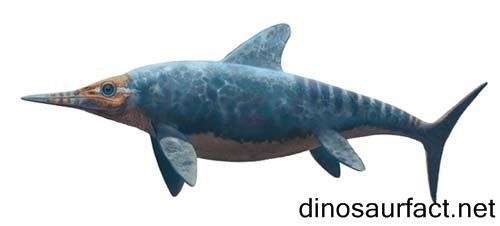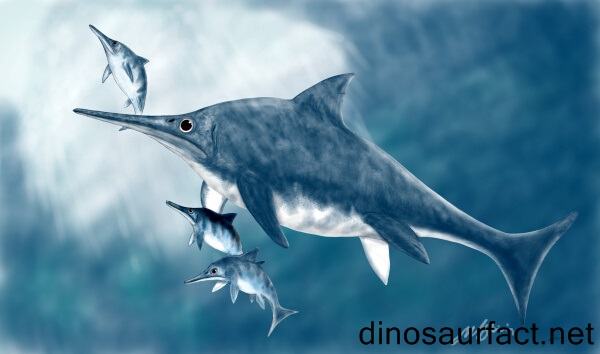 Click to visit the previous Marine Specie bio
Click to visit the previous Marine Specie bio
 |
|
 |
|
Kingdom: Animalia
Phylum: Chordata
Class: Reptilia
SuperOrder: Sauropterygia
Order: Ichthyosauria
Family: Stenopterygiidae
Genus: Stenopterygius
 |
|
 |
|
 |
|

The Stenopterygius was an ichthyosaur reptile that lived on the earth during the Jurassic period. It is grouped under a subclass in order Ichthyosauria which consists of species that resemble the tuna fish. Its forelimbs were much larger than its hind limbs. Such features were seen predominantly in primitive ichthyosaurs.
The Stenopterygius was in existence during the first half of the Jurassic period. This was about 190 to 180 million years ago. This stage lies between the Pleinsbachain and Toarcian ages of the Jurassic period.
The diet of the Stenopterygius consisted of fish and other small marine organisms. Its head was modified to form a pointed snout which facilitated catching its prey. Its lifestyle was comparable to modern day dolphins.
The size of the Stenopterygius was also similar to dolphins. It could achieve a maximum adult size of about 3.8 to 4.2 meters. Its weight was judged to be around 80 to 120 kilos. Even physically, the Stenopterygius looked like a dolphin. But it was not related to the presently existing dolphins. Its acumen is also not expected to be at par with marine mammals.
Discovery of fossils
- The remains of the Stenopterygius were discovered in the mid-1850s. But for almost fifty years they were classified under the genus Ichthyosaurus. Very few aquatic vertebrates were known at that time and hence the confusion was understandable.
- In the year 1904 scientist Otto Jaekel noticed subtle differences between one set of Ichthyosaurus fossils from the others. He grouped them under a separate genus Stenopterygius.
- After this, many other fossils were discovered from all over Europe. They were uncovered from England, France, Germany and Switzerland. The German fossils were in a particularly good state.
- Over a hundred individual specimens have been attributed to the Stenopterygius today.
Nature of fossils
The Stenopterygius remains were very interesting because they had an impression of the skin along with certain internal organs. Although this did not provide any substantial information about its body systems, but its morphology was very well displayed by these fossils.
A diagnostically relevant fossil of the Stenopterygius had a neonatal specimen inside the pelvic cavity of a female. This explained the reproductive characteristics of the Stenopterygius without a doubt.
Etymology
The Stenopterygius was named for the morphology of its extremities. The term ‘stenos’ is the Greek word which means ‘constricted’ in English. The word ‘pteryx’ also has Greek origins and translates to ‘fin’. Thus the name Stenopterygius denotes ‘a narrow fin’.
The name of the genus Stenopterygius was coined by Otto Jaekel.
Classification
- The classification of the Stenopterygius was a challenge from the beginning as it was discovered at a stage when prehistoric marine reptiles were just being discovered.
- Its remains were originally classified with the Ichthyosaurus.
- Currently, only four subspecies of the Stenopterygius are recognized. At one point, more than a dozen were described. Many of the subspecies were discovered to be synonyms of the S. quadriscissus. The other three species are the S. triscissus, S. uniter and the S. aaleniensis. This work of organizing the genus was done by paleontologist Michael Maisch.
- It was found that the fossils of a completely new ichthyosaur were grouped under the genus Stenopterygius. These fossils were christened as the Hauffiopteryx.
- The location of the Stenopterygius within the taxonomic tree was not defined in the early twenty-first century when the genus was described. It is presently classified under order Ichthyosauria, node Thunnosauria and family Stenopterygiidae.
Otto Jaekel
Otto Max Johannes Jaekel was a vertebrate paleontologist. He was born in Prussian Silesia in Germany.
He was highly interested in German Mesozoic fossils and founded the Paleontological Society of Germany so that the efforts of all German geologists could be pooled together. He was very keen on exploring every inch of Germany for prehistoric remains.
Jaekel also served as a lecturer at the University of Vienna in Austria. He then returned to Germany any taught in various colleges there as well.
Despite of his interest invertebrates, he has worked extensively in describing the non-vertebrate Echinodermata.
Jaekel passed away from an unknown ailment in Beijing, China.
Physical characteristics
- The Stenopterygius was a fairly average sized aquatic animal. It could grow to about 12 to 13 feet in length. Its weight is was about 100 to 200 pounds. Since the outline of its skin was also found with its fossils, the size of the Stenopterygius was mostly likely correctly judged.
- The jaw of the Stenopterygius was modified to form a beak like projection. This helped it to reach in between rocks where its prey usually hid.
- Its teeth were tiny and pointed. Such teeth inflicted multiple traumas to its prey, thus assuring that it did not escape.
- The Stenopterygius possessed a prominent dorsal fin.
- The extremities of the Stenopterygius were adapted to a marine environment. They existed in the form of paddles. The cranial flippers were much bigger than the caudal flippers, thus giving the Stenopterygius its name.
- Its tail was bi-lobed like modern cetaceans.
- The body of the Stenopterygius was not very bulky and was streamlined.
Habits and habitat
The Stenopterygius was a meat eating creature. The examination of its stomach contents revealed the presence of fish and cephalopods, thus indicating its diet.
By comparing the morphology of the Stenopterygius with cetaceans, it can be deduced that it was a strong swimmer.
It is very clear that the Stenopterygius gave birth to live off-springs. One of its fossils had a juvenile specimen within the pelvic canal. This feature is seen among other ichthyosaurs as well.
The Stenopterygius was very common in the Jurassic oceans around Europe, as shown by the multiplicity of its fossils. It most likely resided in deeper waters.
Related and coexisting species
The Ichthyosaurus was definitely a close relative of the Stenopterygius. It was also related to the Chacaicosaurus, Hauffiopteryx and the Opthalmosaurus.
The Stenopterygius could have coexisted with the Plesiosaurus and Ichthyosaurus. It shared its environment with the various Jurassic gastropods, cephlaopods, turtles, and crocodiles.
Conclusion
The Stenopterygius was a successful carnivorous reptile. It was adapted for a marine habitat and was a very good hunter.
It is well represented in terms of number of fossils ascribed to it.
The discovery of the Stenopterygius provided scientists with a lot of information about ichthyosaurs, especially their reproductive systems.
Index
Extinct Profiles
 Triassic Dinosaurs
Triassic Dinosaurs Jurassic Dinosaurs
Jurassic Dinosaurs Cretaceous Dinosaurs
Cretaceous Dinosaurs Pterosaurs
Pterosaurs Marine Reptiles
Marine Reptiles Dinosaur Extinction
Dinosaur Extinction